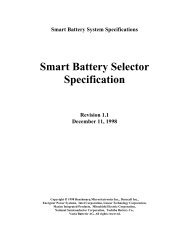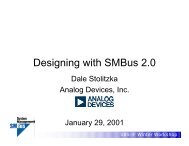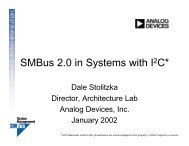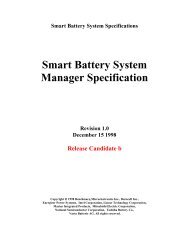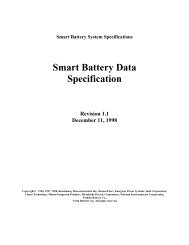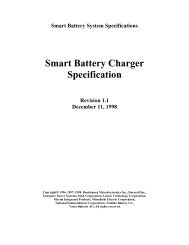CRC-8 firmware implementations for SMBus - SBS-IF Smart Battery ...
CRC-8 firmware implementations for SMBus - SBS-IF Smart Battery ...
CRC-8 firmware implementations for SMBus - SBS-IF Smart Battery ...
- No tags were found...
Create successful ePaper yourself
Turn your PDF publications into a flip-book with our unique Google optimized e-Paper software.
6%6,)'HY&RQ-DSDQ<strong>CRC</strong>-8 <strong>firmware</strong><strong>implementations</strong> <strong>for</strong> <strong>SMBus</strong>John MiliosUSAR Systems<strong>CRC</strong>-8 tutorial <strong>for</strong> <strong>SMBus</strong>, John Milios, USAR Systems
6%6,)'HY&RQ-DSDQScope• <strong>CRC</strong>-8 has been defined as optional featureof <strong>SMBus</strong> V1.1• Packet Error Checking will improve thereliability of the bus• Let’s make sure that we understand it thesame way<strong>CRC</strong>-8 tutorial <strong>for</strong> <strong>SMBus</strong>, John Milios, USAR Systems
6%6,)'HY&RQ-DSDQ<strong>CRC</strong>’s basic idea• The remainder of a division changes a lot with smallchanges in the dividend..0000001101 = Quotient1001 0001100001 = DividendDivisor 0001,.. .,0000,.. .,0011.. .,0000.. .,0110. .,0000. .,1100 .,1001 .,1010.,1001.,0110,0000,11001001101<strong>CRC</strong>-8 tutorial <strong>for</strong> <strong>SMBus</strong>, John Milios, USAR Systems
6%6,)'HY&RQ-DSDQPolynomial arithmetic mod 2• No propagation of carry• Addition AND subtraction are per<strong>for</strong>med with XOR• Multiplication is similar with binary except that sumsare calculated with XORs• Division relies on “weak” definition of larger or equal3 X is greater than or equal to Y if and only if the position ofthe highest 1 bit of X is the same or greater of the highest 1bit of Y<strong>CRC</strong>-8 tutorial <strong>for</strong> <strong>SMBus</strong>, John Milios, USAR Systems
6%6,)'HY&RQ-DSDQ<strong>CRC</strong> calculation• We need the following:• A polynomial of width M (divisor). In the case of <strong>SMBus</strong>, thepolynomial will be using is X8 + X2 + X + 1. The width ofthis polynomial is 8 (the highest power of X indicates thewidth) and it can be represented as 1 0000 0111. Since thewidth of the polynomial is 8 we refer to our <strong>CRC</strong> method as<strong>CRC</strong>-8.• A message represented as a bit-stream augmented with M =8 zeroes at the end.• Division of the augmented bit-stream message by thepolynomial 0000 0111. The remainder will be the <strong>CRC</strong>-8check byte.<strong>CRC</strong>-8 tutorial <strong>for</strong> <strong>SMBus</strong>, John Milios, USAR Systems
6%6,)'HY&RQ-DSDQ<strong>CRC</strong> calculation example3 Our polynomial is: s¬¬¬¬˜¬sss.The original message is : ¬s¬s˜ss¬¬.After we augment it with 8 zeroes it becomes: ¬s¬s˜ss¬¬˜¬¬¬¬˜¬¬¬¬We ignore the quotient as it is not used in the <strong>CRC</strong> calculation.0101110000000000 =<strong>CRC</strong>100000111 XOR polynomial001110111000000 =<strong>CRC</strong>100000111 XOR polynomial0110110110000 =<strong>CRC</strong>100000111 XOR polynomial010110001000 =<strong>CRC</strong>100000111 XOR polynomial00110010100 =<strong>CRC</strong>100000111 XOR polynomial• 010010011 =<strong>CRC</strong><strong>CRC</strong>-8 tutorial <strong>for</strong> <strong>SMBus</strong>, John Milios, USAR Systems
6%6,)'HY&RQ-DSDQWhat to do with <strong>CRC</strong>3 The original message can be appended with the calculated<strong>CRC</strong>-8 byte and transmitted to the receiver.3 The <strong>CRC</strong>-8 enhanced message will be 0101 1100 10010011.3 The receiver can per<strong>for</strong>m the same calculation upon the first 8bits of the original message and then compare the result withthe received <strong>CRC</strong>-83 Or calculate the <strong>CRC</strong>-8 upon the whole (16 bits in this example)message, without appending zeroes and verify that theoutcome is zero.<strong>CRC</strong>-8 tutorial <strong>for</strong> <strong>SMBus</strong>, John Milios, USAR Systems
6%6,)'HY&RQ-DSDQThe algorithm <strong>for</strong> the examplePolynomial1b7 b6 b5 b4 b3 b2 b1 b00 0 0 0 0 1 1 1Augmentedmessage• Initialize the shift register with zeroes• Shift left the augmented message until a 1 comes out• XOR the contents of the register with the low eight bits of thepolynomial• Continue until the whole message has passed through the shiftregister (the trailing zero bits will be the last ones to fill the registerand their role is to push out the original message)• The <strong>CRC</strong>-8 is the last value of the shift register3 Calculator Example<strong>CRC</strong>-8 tutorial <strong>for</strong> <strong>SMBus</strong>, John Milios, USAR Systems
6%6,)'HY&RQ-DSDQImplementation problems• Easier to implement in hardware• In real communication systems including<strong>SMBus</strong> you may not want to put thecalculation load at the end• It takes long time• You need to respond fast with ACK, NACK• How can you per<strong>for</strong>m the calculation byte bybyte?<strong>CRC</strong>-8 tutorial <strong>for</strong> <strong>SMBus</strong>, John Milios, USAR Systems
6%6,)'HY&RQ-DSDQBack to arithmetic...• What we need is A/B = Q + R• In <strong>CRC</strong> we are interested in only on theremainder so we can re-write our expressionas A/B => R• If we express A = A1 + A2 then our taskwould be described as• (A1+A2)/B =>R• or A1/B + A2/B = (Q1 + R1/B) + A2/B• or Q1 + (R1 + A2)/B =>R<strong>CRC</strong>-8 tutorial <strong>for</strong> <strong>SMBus</strong>, John Milios, USAR Systems
6%6,)'HY&RQ-DSDQTwo different methods010110000000 =<strong>CRC</strong>11010 XOR with polynomial in 2 nd position01100000000 =<strong>CRC</strong>11010 XOR with polynomial in 3 rd position0001000000 =<strong>CRC</strong>11010 XOR with polynomial in 6 th position0101000 =<strong>CRC</strong>11010 XOR with polynomial in 7 th position011100 =<strong>CRC</strong>11010 XOR with polynomial in 8 th position6WUDLJKWIRUZDUG00110 =<strong>CRC</strong>01010000 =<strong>CRC</strong>11010 XOR with polynomial(2 nd position)0111000 =<strong>CRC</strong>11010 XOR with polynomial(3 rd position)001100 =<strong>CRC</strong> (completed calculation with first number)10000000 Add (XOR) now the remainder to the second nibble01000000 =<strong>CRC</strong>11010 XOR with polynomial(6 th position)0101000 =<strong>CRC</strong>11010 XOR with polynomial(7 th position)011100 =<strong>CRC</strong>11010 XOR with polynomial (8 th position)00110 = <strong>CRC</strong>%UHDNLQJWKHPHVVDJHLQWRDVXP<strong>CRC</strong>-8 tutorial <strong>for</strong> <strong>SMBus</strong>, John Milios, USAR Systems
6%6,)'HY&RQ-DSDQInteresting observations• We can use the <strong>CRC</strong> value derived from the firstnibble and add it (XOR) to the second nibble in orderto continue the calculation• The XORs of the dividend with the polynomial occurin the same bit positions• If we XOR the polynomial shifted into these positionswe will derive the original bit-stream augmented withthe <strong>CRC</strong> as it is shown below_11010__11010_____11010______11010_______11010010110000110<strong>CRC</strong>-8 tutorial <strong>for</strong> <strong>SMBus</strong>, John Milios, USAR Systems
6%6,)'HY&RQ-DSDQ1st method - Direct• Initialize the <strong>CRC</strong> register with zeroes• Per<strong>for</strong>m the straight<strong>for</strong>ward algorithm (bit bybit) on the first byte augmented by 8 zeroes• XOR the <strong>CRC</strong> with the next byte andcalculate again with the straight<strong>for</strong>wardmethod• Until the whole message is passed throughthe calculation<strong>CRC</strong>-8 tutorial <strong>for</strong> <strong>SMBus</strong>, John Milios, USAR Systems
6%6,)'HY&RQ-DSDQDirect method sample code* This code calculates a new <strong>CRC</strong> value <strong>for</strong> each byte received* Registers used:* Accumulator A* Index X* Memory register <strong>CRC</strong>* Memory register temp** Input: Memory register <strong>CRC</strong> contains the previously calculated <strong>CRC</strong> value –initialized to zero* Accumulator A contains the next input data byte* Output: Memory register <strong>CRC</strong> contains the current <strong>CRC</strong> value• Minimum overhead to enter: [6] (jump to subroutine call)• [x] denotes machine cycles <strong>for</strong> each instructioninit_crc:ldx #8 [2] ;initialize x-register with the # of bits to be shiftedeor <strong>CRC</strong> [4] ; X-OR new byte with contents of memory location <strong>CRC</strong> in order to obtain(remainder + next incoming byte)crc_loop:* start the straight<strong>for</strong>ward approachrola [3] ; rotate left and place the MSB into the Carry* rola operation fills the empty bits with zeroesbcc zero [3] ; if carry is clear no need to do anything, continueeor #$07 [2] ; else, per<strong>for</strong>m the X-OR of <strong>CRC</strong> with the polynomialzero:decx [3] ; decrement bit counterbne crc_loop [3] ; if more bits need to be processed repeat the loopsta <strong>CRC</strong> [5] ; save the new <strong>CRC</strong> valuereturn:rts [6] ; no more bits, return from subroutine<strong>CRC</strong>-8 tutorial <strong>for</strong> <strong>SMBus</strong>, John Milios, USAR Systems
6%6,)'HY&RQ-DSDQDirect method per<strong>for</strong>manceFoscExecution time<strong>for</strong> one by teOverhead <strong>for</strong> “5bytes” protocolsMsg Transfer Time*= 1.5 msOverhead <strong>for</strong> “35bytes” protocolsMsg transfer time =10.5 ms4 MHz 68us 340 us 2.36 ms2 MHz 135 us 680 ms 4.75 ms1 MHz 270 us 1.35 ms 9.45 ms600 KHz 450 us 2.25 ms 15.75 secMachine cycles required = 135SM Bus operates at 30KHz<strong>CRC</strong>-8 tutorial <strong>for</strong> <strong>SMBus</strong>, John Milios, USAR Systems
6%6,)'HY&RQ-DSDQRecall• All it matters is the positions of the polynomialwhen shifted• We know the positions if we know the databyte• We can ADD (XOR) the <strong>CRC</strong> of the first bytewith the next incoming byte• All we need is a table• Calculator example<strong>CRC</strong>-8 tutorial <strong>for</strong> <strong>SMBus</strong>, John Milios, USAR Systems
6%6,)'HY&RQ-DSDQ2nd method- 256 lookup table• Initialize the <strong>CRC</strong> register to 0• XOR each incoming byte with the previous <strong>CRC</strong>value (Add the remainder of the previous divisionwith the new value). The result is the new bytethat we need to calculate the <strong>CRC</strong> value (orremainder of the division)• Use this value as the index to the table to obtainthe new remainder• Continue until you have passed all bytes throughthe process• The last byte retrieved from the table is the final<strong>CRC</strong> value<strong>CRC</strong>-8 tutorial <strong>for</strong> <strong>SMBus</strong>, John Milios, USAR Systems
6%6,)'HY&RQ-DSDQCode example* This code per<strong>for</strong>ms a table lookup to determine the new <strong>CRC</strong> value <strong>for</strong> each byte received* Registers used:* Accumulator A* Memory register <strong>CRC</strong>** Input: Memory register <strong>CRC</strong> contains the previously calculated <strong>CRC</strong> value* Accumulator A contains the input data byte* Output: Memory register <strong>CRC</strong> contains the current <strong>CRC</strong> valueget_crc:eor <strong>CRC</strong> [4] ; X-OR the received byte with the stored <strong>CRC</strong> value (result inACC)tax [2] ; no need to pay taxes yet... just transfer ACC to X registerlda table,x [5] ; load the new <strong>CRC</strong> value from the lookup tablesta <strong>CRC</strong> [4] ; save the new <strong>CRC</strong> value*Calculator example<strong>CRC</strong>-8 tutorial <strong>for</strong> <strong>SMBus</strong>, John Milios, USAR Systems
6%6,)'HY&RQ-DSDQ2nd method per<strong>for</strong>manceFoscExecutiontime <strong>for</strong> onebyteOverhead <strong>for</strong> “5bytes” protocolsMsg Transfer Time*= 1.5 msOverhead <strong>for</strong> “35bytes” protocolsMsg transfer time =10.5 ms4 MHz 7.5 us 37.5 us 262 us2 MHz 15 us 75 us 525 us1 MHz 30 us 150 us 1 ms600 KHz 50 us 250 us 1.75 msMachine cycles required = 15<strong>CRC</strong>-8 tutorial <strong>for</strong> <strong>SMBus</strong>, John Milios, USAR Systems
6%6,)'HY&RQ-DSDQWorking with nibbles• The same method can be applied to nibblesinstead of bytes• Results in a much smaller table (16 bytes)• Good <strong>for</strong> 4-bit MCUs• A lot of shifts <strong>for</strong> 8-bit MCUs• But it saves ROM space and it is faster thanthe direct method calculation• Calculator example<strong>CRC</strong>-8 tutorial <strong>for</strong> <strong>SMBus</strong>, John Milios, USAR Systems
6%6,)'HY&RQ-DSDQPer<strong>for</strong>manceFosc Execution time Overhead <strong>for</strong> “5<strong>for</strong> one byte (us) bytes” protocolsMsg Transfer Time*= 1.5 msOverhead <strong>for</strong> “35bytes” protocolsMsg transfer time =10.5 ms4 MHz 45 225 us 1575 us2 MHz 90 450 us 3150 us1 MHz 180 900 us 6300 us600 KHz 300 1500 us 10500 usMachine cycles required = 90<strong>CRC</strong>-8 tutorial <strong>for</strong> <strong>SMBus</strong>, John Milios, USAR Systems
6%6,)'HY&RQ-DSDQImproved 32 byte table lookup• We can eliminate some of the shifts bycreating a second 16 byte table with reversednibbles• Example• 07 -> 70• Improves per<strong>for</strong>mance in 8-bit MCUs<strong>CRC</strong>-8 tutorial <strong>for</strong> <strong>SMBus</strong>, John Milios, USAR Systems
6%6,)'HY&RQ-DSDQ32 byte table per<strong>for</strong>manceFoscExecution time<strong>for</strong> one by te (us )Overhead <strong>for</strong> “5bytes” protocolsMsg Transfer Time*= 1.5 msOverhead <strong>for</strong> “35bytes” protocolsMsg transfer time =10.5 ms4 MHz 30 150 us 1050 us2 MHz 60 300 us 2100 us1 MHz 120 600 us 4200 us600 KHz 199 995 us 6965 usMachine cycles required = 60<strong>CRC</strong>-8 tutorial <strong>for</strong> <strong>SMBus</strong>, John Milios, USAR Systems
6%6,)'HY&RQ-DSDQ<strong>CRC</strong>-8 polynomial• Polynomial: X8+X2+X1+X0• It will detect all single bit errors• All Odd number of bit errors• Any burst error less than 8 bits long• Most of other type of errors<strong>CRC</strong>-8 tutorial <strong>for</strong> <strong>SMBus</strong>, John Milios, USAR Systems
6%6,)'HY&RQ-DSDQConclusions• By understanding the <strong>CRC</strong> principlesalgorithms can be devised to address anyspeed/space condition• It is important <strong>for</strong> the <strong>CRC</strong>-8 results to agree• The <strong>CRC</strong> calculator will be made availablealong with the source code at www.usar.com• <strong>CRC</strong>-8 calculator and white paper available<strong>for</strong> download from USAR’s web-site<strong>CRC</strong>-8 tutorial <strong>for</strong> <strong>SMBus</strong>, John Milios, USAR Systems




